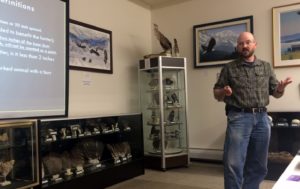
An example of when the new rule might apply. (Slide via ADFG)
The moose hunting season starts around Haines in Game Management Unit 1D on Sept. 15. All the same rules and regulations as last year apply this season, but there’s an addition in the mix. The change is aimed to help, not hinder, hunters.
If you’ve heard it once, you’ve heard it a hundred times: 50 inches is 50 inches. That cardinal rule of the moose hunt, plus the spike-fork and three-brow-tine regulations are still in effect. But there is one change to the rules that state biologists say will be helpful.
“First, let me say, if it was a legal moose last year, it’s a legal moose this year, says Carl Koch, the assistant area biologist for the Alaska Department of Fish and Game. “That’s the easiest way for me to say, don’t get stressed about the change.”
Koch spoke to a handful of hunters at a meeting Thursday night in Haines about the upcoming hunt, and the regulation change.

ADF&G biologist Carl Koch talks to Hunters on Thursday, Sept. 8 in Haines. (Jillian Rogers)
“There is a change in that a forked animal, and I’ll show you some examples soon, if there’s a point within two inches of the base, and it’s less than three inches long, it will not count as a point. It will not make the forked animal illegal.”
What that means is, if there’s a small protuberance close to the moose’s head, one that can easily be hidden by an ear, it doesn’t count as a point if, and only if, it’s two inches from the base of the antler and less than three inches long. This change only applies on small-antlered moose that would have a spike or forked antler. It does not apply on large antler moose that are deemed legal by rack size – 50 inches or more – or three or more brow tines.
So, Koch says, it helps hunters.
“The reason that came to be was because some people in Wrangell put a proposal through, they felt like those were really close to the head on these forked moose, maybe you couldn’t even see it behind the ear,” he says. “You could walk up on a moose and it might be illegal. So, this works as a benefit to the hunter.”
The season starts on Thursday and runs through Oct. 7. That’s the plan, anyway. Last year, the season was closed a week early because 22 legal, and two sublegal, bulls were harvested, which is about the cutoff.
Last year’s aerial-survey bull-to cow-radio was 18. Koch says the department would like to see it at 25, and until then they’ll be on the conservative side as far as harvest goes. The limit is between 20 and 25 moose in unit 1D.
“If it starts creeping up on 25, we’re going to think about closing it,” he says. “If the hunt goes the same, exact way it went last year, probably the same thing will happen. If it’s at 23 and it’s toward the end of the season, we’ll make the judgement in-season on the fly, so to speak, as we gather data from the harvest. The other thing about the last two harvests was that the spike-forks were very low, so it’s an index of low recruitment.”
Last season, the hunt went fast. Seventeen moose were harvested in the first week of the hunting period. Koch says 250 permits were issued, but only 187 were used. Overall there was a 13 percent success rate, even with the early closure, which is about average.
When biologists took to the air for the annual aerial survey in 2015, they counted 183 moose in the Chilkat Valley, up from 147 the year before. However, in 2014, the count was done in the spring in poor conditions, which might partially account for the lower total. Koch says even though the total count, including the number of calves, was higher in 2015, the department is still being cautious when it comes to the harvest. He says only four spike-fork, or younger moose were harvested last year, and just three the season before.
“And low calf count during the 2014 survey, we only had eight percent of the total count were calves. And so, again, we closed the season one week early. But just to reiterate, 24 moose were harvested, and the percent success rate was very similar to what it always is.”
Of those 24, two were taken illegally, which is part of the reason for the hunter education meetings pre-season. But wildlife Trooper Trent Chwialkowski says illegal moose shot in this area are usually dropped by accident.
“No one around here is going to go out and try to poach an undersized moose,” he says. “They simply make a mistake, and with that mistake, they have the ability to self-surrender, or self-report. And we encourage that. Everyone can make a mistake. When they (self-surrender) the punishment is much less severe than had they try to hide it.”
Chwialkowski says if someone shoots a sub-legal moose and turns themselves in, the punishment is a citation and fine of up to $500.
Both the trooper and the biologist reminded hunters that if they’re in doubt about a moose, don’t shoot. Along with last year’s two sublegal moose, there were four spike-fork, 12 three-brow tine and six 50-plus-inch moose harvested.









